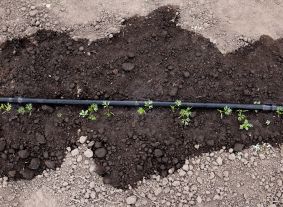How to Contain Zucchini in a Small-Space Garden
Views: 9826
I’m not exactly sure how it happened—it could have been the wonderfully rich compost I added to our garden, or perhaps it was several applications of a reliable fertilizer—but one of our two gardens is growing like gangbusters. The tomatoes and peppers are the healthiest I’ve ever grown. The kale and chard are gorgeous (except for a few pesky leaf miner issues). And the zucchini and squash plants are, as chef Guy Fieri would say, “out of bounds.”
Literally, they are out of bounds—the makeshift walkway I created in the garden within which I planted three zucchini plants and three summer squash plants. Six plants? I know, not a smart idea. But I did it. And now I have to live with the results. The plants are developing giant leaves and fruit-producing vines that are quickly encroaching into the kale, tomatoes, peppers, and herbs. The squash area is contained on one side with the short wooden wall along one edge of the garden. However, if left unchecked, the plants would eventually cover the entire garden. Again, I know—not a smart thing to do, planting so many squash. It happens every year.
Control your squash and zucchini
Last week a garden friend informed me the same thing was happening in her garden, and she asked for advice on how to control her quickly growing squash. Thinking on her issue and mine, I came up with a solution for my small-space garden.
I purchased an 8-ft. length of 2-ft. high lattice at the hardware store. Then, I cut it in half and secured two wooden garden stakes to one long edge of each section. I then inserted the lattice sections along the left and top sides of the squash area, essentially fencing in the wayward zucchini and squash leaves. I left the right side of that area open for now as that side is planted a little less densely. Thus far the lattice fence is containing the squash well.
Lattice pros and cons
What’s good about the lattice? It’s allows for more air movement for the kale and tomatoes, and also more light for the tomatoes to ripen. It has also opened up that walkway for use.
What is bad about the lattice? Nothing yet. However, as the plants grow and the leaves become more dense inside the lattice, I can imagine it’ll result in faster spreading of powdery mildew—because powdery mildew certainly will appear. The thicket of leaves will also make it harder to see and harvest fruits that are ready.
Ask me in two months if this lattice idea was genius or a big fat fail. Meanwhile, it’s working, and that’s a good thing.
Meet Ellen Wells
When you’re raised on a farm, you can’t help but know a thing or two about gardening. Ellen Wells is our expert on edible gardening.…
Ellen's Recent Posts

Asparagus






